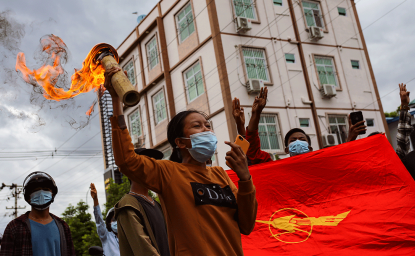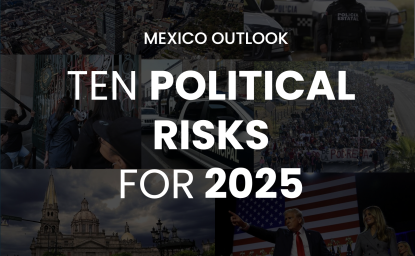The establishment of autonomous agencies in Mexico originates from the democratic transition that unfolded during the late 20th century. This period marked a significant transformation in the political landscape, characterized by the creation of institutions designed to enhance governance and public policy in areas such as economic regulation, electoral governance, and human rights. Constitutional amendments enabled the formation of these entities, which were structured to operate independently of direct government control, thereby promoting accountability and transparency in public administration.[1][2]
During the 1990s, the emergence of autonomous technical bodies was viewed as a step toward modern and stable governance. These institutions were intended to act as checks on governmental authority, ensuring the provision of critical public services free from political interference. For instance, the National Electoral Institute (INE)[3] and the National Commission for Human Rights (CNDH)[4] became critical players within this framework, with mandates to safeguard electoral processes and protect human rights. In the economic sphere, the Central Bank of Mexico gained autonomy in 1994 and was tasked with maintaining price stability—a role that would contribute to macroeconomic resilience for decades.[5] Similarly, the National Institute of Statistics and Geography (INEGI), responsible for collecting and publishing socioeconomic data, including inflation statistics, became autonomous in 2008.[6] Over the past decade, this model has expanded to encompass institutions responsible for fostering competition, regulating energy markets, promoting transparency, and evaluating social and educational policies.[7]
The contributions of many of these institutions are widely acknowledged. For example, central bank autonomy is recognized in economic literature as a critical factor in maintaining price stability. Institutions such as the European Central Bank, the US Federal Reserve, and the Bank of Mexico[8] are often cited as examples of technical independence. Similarly, the INE in Mexico, alongside electoral commissions in countries like Ghana, has played an instrumental role in facilitating peaceful democratic transitions by acting as impartial arbiters in politically sensitive environments.[9] [10]
Nevertheless, autonomous agencies globally have encountered growing scrutiny from various sectors of society. Critics argue that, despite their independence, some of these entities may exhibit technocratic tendencies and insufficient responsiveness to public concerns. Allegations of illegitimacy and bureaucratic inefficiency have been raised in national media, sparking debates over the need for reforms and improved accountability mechanisms. In some cases, these institutions have faced accusations of advancing political agendas, raising questions about their impartiality and effectiveness.[11][12]
The critique of technical autonomy should not be interpreted as a demand for its abolition but as a call to recalibrate its scope and role in public governance. Political philosopher Jürgen Habermas, for instance, advocates for a model of “deliberative democracy” where technical expertise and citizen input converge to guide public decision-making.[13] Similarly, Sheila Jasanoff’s concept of “participatory science” emphasizes inclusive processes that integrate expert knowledge with societal values.[14]
Mexico’s current debates on technical autonomy reflect these broader tensions. President López Obrador’s administration proposed in early 2024 a constitutional reform to dismantle several key autonomous bodies, citing concerns over democratic legitimacy, political biases, and operational costs. This reform, approved in November 2024,[15] aims to consolidate the functions of these agencies within central government ministries.[16]
An analysis by the Mexican Institute for Competitiveness (IMCO), a leading think tank, highlights potential risks associated with transferring the responsibilities of autonomous bodies to centralized ministries. For instance, the Federal Economic Competition Commission (COFECE) and the Federal Institute of Telecommunications (IFT) would lose their independent status, which could enable executive decisions that undermine impartial competition policies and discourage investment. Such changes may also risk breaching trade obligations under the United States-Mexico-Canada Agreement (USMCA), which requires independent regulatory bodies in telecommunications and competition law.[17]
In the energy sector, IMCO warns that dissolving the Energy Regulatory Commission (CRE) could result in conflicts of interest, as the Ministry of Energy would regulate state enterprises such as Pemex and the Federal Electricity Commission (CFE). This could jeopardize impartiality and compliance with international agreements. Similarly, transferring transparency and data protection functions to ministries or state-controlled bodies—by eliminating the National Institute for Access to Information (INAI)—might weaken accountability and restrict public access to information, potentially violating USMCA anti-corruption provisions. Furthermore, shifting the evaluation of social and educational policies to the Ministry of Education could reduce evidence-based policy assessments, potentially diminishing the effectiveness of public spending in critical areas such as poverty alleviation and education quality. [18]
Critics argue that dismantling autonomous agencies represents an institutional regression that could weaken the Mexican state’s technical capacities.[19] This shift may hinder alignment with international best practices and, in some cases, jeopardize compliance with global commitments. Nevertheless, while the positive contributions of major institutions—such as the Central Bank of Mexico[20] and the INE,[21] which remain unaffected by the reform—to Mexico’s economic and political stability are widely recognized, the impact of many autonomous agencies targeted for dissolution in the 2024 reform on the economy and public welfare is less clear. This uncertainty partly reflects a lack of systematic evaluations of their effectiveness. As these institutions face elimination, this evidentiary gap highlights the need for comprehensive assessments to evaluate their contributions to public policy. [22]
Even with the elimination of autonomous agencies, opportunities may exist to shape reforms in ways that preserve essential elements of independence and accountability within newly centralized structures. For example, reforms could specify the technical, operational, and managerial autonomy of the decentralized or administrative units absorbing these functions, defining their independence in secondary laws. Additionally, legislative oversight mechanisms could be introduced, requiring the heads of these units to report regularly to Congress on progress and performance. These measures could help ensure impartiality and transparency in decision-making.
To facilitate a smooth transition, IMCO suggests that it is essential to establish protocols for transferring institutional capacities, including human resources, knowledge, technologies, and methodologies. Strategies for team integration, training, and inter-agency coordination would support this effort. Maintaining collegial decision-making processes within the absorbing agencies could help prevent the concentration of interests and reinforce impartial governance. Clear guidelines for managing records, registries, and digital platforms are crucial to ensure continued access to data and institutional memory. A monitoring team within the Senate's USMCA Implementation and Review Commission could also oversee potential treaty compliance issues arising from the reform, ensuring alignment with Mexico’s international commitments.16
Mexico’s reform of autonomous agencies represented an opportunity to recalibrate the balance between technical autonomy and democratic governance. These bodies, while often critiqued for their perceived lack of democratic legitimacy, contributed significantly to building the Mexican state’s technical capacities. A reform focused on merit-based, transparent leadership selection processes—overseen by diverse committees including experts and civil society representatives—could have strengthened these institutions' capacity and legitimacy. However, with the reform now approved and consolidating these agencies within government ministries, this opportunity to enhance democratic legitimacy and institutional accountability has been lost. The focus must now shift to mitigating significant risks to transparency, impartiality, and the quality of governance while seeking ways to preserve the technical capacities that these agencies have provided.
*This article was written prior to the approval of the constitutional reform in the House of Representatives on November 20
[1] Cervantes, Y. M. C. (1998). La división de poderes y los órganos constitucionales autónomos en México, propuestas para la reforma del Estado. Alegatos, (39), 329-348.
[2] Fabián Ruíz, J. (2017). Los órganos constitucionales autónomos en México: una visión integradora. Cuestiones constitucionales, (37), 85-120.
[3] Nuñez Castañeda, J. (2015). La autonomía de los órganos electorales en México. OPENAIRE. Retrieved November 19 2025 from: http://biblio.upmx.mx/tesis/150454.pdf
[4] Barragán, J. M. (2008). La Comisión Nacional de los Derechos Humanos y su aporte en el Proceso democratizador del Estado mexicano. Deusto Journal of Human Rights, (5), 125-139.
[5] Marichal, C. (2001). Eduardo Turrent: Historia del Banco de México, 1940–1946, vol. 2, Mexico, 2001. Revista de Historia Economica-Journal of Iberian and Latin American Economic History, 19(2), 474-477.
[6] García Jiménez, C. I. (2019). Los órganos constitucionales autónomos y la división de poderes en México: el caso del Instituto Nacional de Estadística y Geografía (INEGI), 1994-2017 (Doctoral dissertation, Universidad Autónoma de la Ciudad de México: Colegio de Humanidades y Ciencias Sociales: Licenciatura en Ciencia Política y Administración Urbana). Retrieved November 19 2025 from: https://www.repositorioinstitucionaluacm.mx/jspui/bitstream/123456789/123/3/C%C3%A9sar%20Iv%C3%A1n%20Garciaa%20Jim%C3%A9nez_unlocked.pdf
[7] Ackerman, J. (2010). Organismos autónomos y la nueva división de poderes en México y América Latina. Homenaje al Doctor Emilio O. Rabasa, México, IIJ-UNAM. Retrieved November 19 2025 from: https://shorturl.at/hgLSM
[8] Arnone, M., Laurens, B. J., Segalotto, J. F., & Sommer, M. (2009). Central bank autonomy: Lessons from global trends. IMF Staff Papers, 56(2), 263-296.
[9] Yarza, L. A. T. (2019). Building Democracy: De Jure and De Facto Autonomy in Electoral Management Bodies in Latin America and Africa (Doctoral dissertation, University of Pittsburgh). Retrieved November 19 2025 from: https://d-scholarship.pitt.edu/35739/1/Dissertation%20(Alejandro%20Trelles%2001.07.19)%20ETD.pdf
[10] Debrah, E. (2011). Measuring governance institutions' success in Ghana: the case of the electoral commission, 1993–2008. African Studies, 70(1), 25-45.
[11] Ackerman, J. M. (2007). Organismos autónomos y democracia: el caso de México. Editorial Siglo XXI.
[12] Ferraro, A. E., & Fondevila, G. (2023). Islands of power. Democratic legitimacy, autonomous organisms, and their conflict in Mexico. Administrative Theory & Praxis, 45(4), 335-358.
[13] Susen, S. (2017). Jürgen Habermas: Between democratic deliberation and deliberative democracy. In The Routledge handbook of language and politics (pp. 43-66). Routledge.
[14] Jasanoff, S. (2005). Technologies of humility: Citizen participation in governing science (pp. 370-389). Verlag für Sozialwissenschaften.
[15] The reform was approved by the Chamber of Deputies on November 21, 2024. As in similar cases, the approval process is expected to proceed smoothly and be completed within the next few weeks.
[16] Arredondo Martínez, Y. (2022). Los órganos constitucionales autónomos en el gobierno de Andrés Manuel López Obrador: conflictos y posibilidades. Interdisciplina, 10(27), 315-345.
[17] IMCO. (2024, November 11). Desaparición de órganos autónomos. Instituto Mexicano para la Competitividad, A.C. Retrieved November 19 2025 from: https://imco.org.mx/desaparicion-de-organos-autonomos/
[18] White & Case LLP. (2024, February 12). Constitutional and legal reform initiatives proposed by President Andrés Manuel López Obrador. Retrieved November 19 2025 from: https://www.whitecase.com/insight-alert/constitutional-and-legal-reform-initiatives-proposed-president-andres-manuel-lopez
[19] Uvalle Aguilera, R. A. (2024). La posible extinción de los órganos constitucionales autónomos como una estrategia de regresión estatal. In Instituto de Investigaciones Jurídicas de la UNAM (Ed.), Análisis técnico de las 20 iniciativas de reformas constitucionales presentadas por el Ejecutivo Federal en 2024 (pp. 97–112). Universidad Nacional Autónoma de México. Retrieved November 19 2025 from: https://archivos.juridicas.unam.mx/www/bjv/libros/15/7483/9.pdf
[20] Rubli Kaiser, F. (1996). Autonomía del Banco Central bajo tensión financiera: la experiencia reciente de México. Retrieved November 19 2025 from: https://repositorio.cepal.org/server/api/core/bitstreams/1f2767b0-575d-45c1-8a64-23aeaea6e5c8/content
[21] Woldenberg, J. (2012). Historia mínima de la transición democrática en México. El Colegio de Mexico AC.
[22] Although the government cites high operational costs as justification for their elimination, empirical research evaluating their cost-effectiveness or value for money is limited. While benefits like transparency are challenging to quantify, measurable economic impacts—such as those linked to competition agencies—remain largely unexplored. For instance, competition-related effects have been analyzed in sectors like telecommunications, finance, and high-profile monopolistic industries, but systematic reviews of their broader economic impact, particularly in peer-reviewed academic journals, are rare.
Author


Mexico Institute
The Mexico Institute seeks to improve understanding, communication, and cooperation between Mexico and the United States by promoting original research, encouraging public discussion, and proposing policy options for enhancing the bilateral relationship. A binational Advisory Board, chaired by Luis Téllez and Earl Anthony Wayne, oversees the work of the Mexico Institute. Read more

Explore More
Browse Insights & Analysis
Myanmar Four Years After the Coup: Is the Resistance Gaining Momentum?

Four Years After the Coup, Myanmar’s Fight for Democracy Endures


